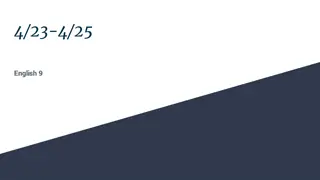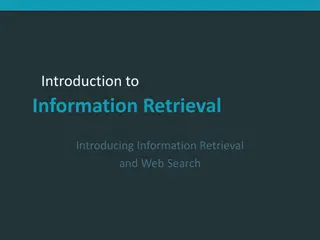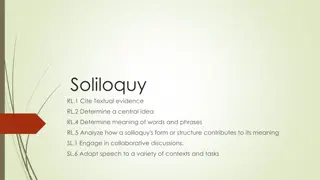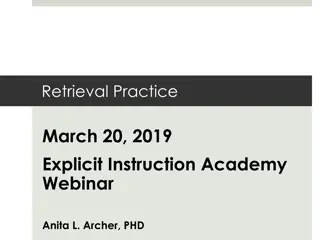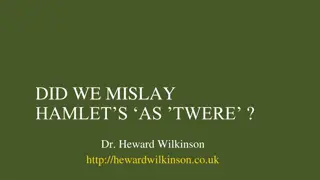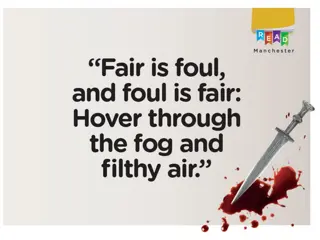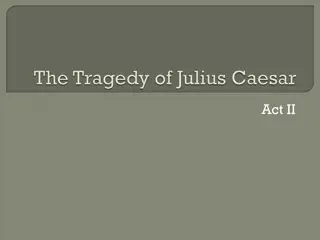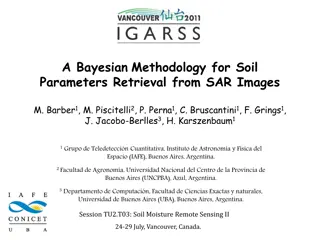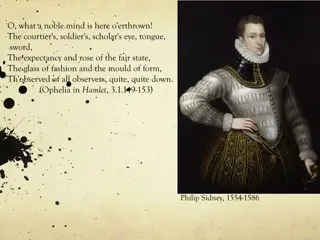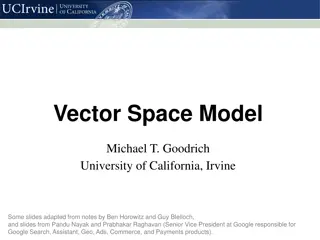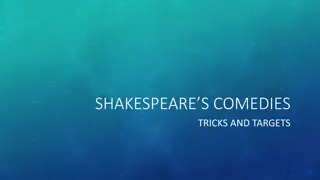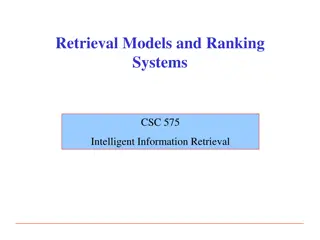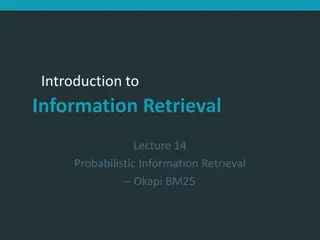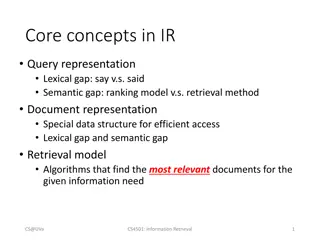Shakespearean Retrieval Practice for Students
Explore key facts and insights related to Shakespeare and his works through retrieval practice questions and answers. Test your knowledge on topics like Elizabethan England, sonnets, soliloquies, and literary devices used in Romeo and Juliet. Enhance your understanding of Shakespearean literature in an interactive way.
Download Presentation

Please find below an Image/Link to download the presentation.
The content on the website is provided AS IS for your information and personal use only. It may not be sold, licensed, or shared on other websites without obtaining consent from the author. Download presentation by click this link. If you encounter any issues during the download, it is possible that the publisher has removed the file from their server.
E N D
Presentation Transcript
Retrieval Practice Romeo and Juliet
Retrieval Practice: Lesson 4 1. What do we call the period of time from 1558-1603? Why? 2. What is a spoken introduction of a play called? 3. Where was Shakespeare born? 4. What was built in London in 1599? What would take place in this building? 5. What is a tragedy tragedy? ? Take 3 minutes to complete these questions 6. What is a comedy comedy? ? Which would you rather see?
Retrieval Practice Answers: Lesson 4 1. The period of time from 1558-1603 is the Elizabethan Era or Elizabethan England because it is named after Queen Elizabeth I who ruled then. 2. A spoken introduction to a play is called a prologue. 3. Shakespeare was born in Stratford-upon-Avon. 4. The Globe Theatre was built in London in 1599. Many of Shakespeare s plays were performed in the Globe. 5. A tragedy tragedy is a play in which a character suffers a serious downfall or a death. 6. A comedy comedy is a play in which characters overcome struggles in an entertaining way. <Answers may vary> Self-score: ______ /6
Retrieval Practice: Lesson 8 1. What is a sonnet sonnet? 2. How many quatrains are in an English or Shakespearean sonnet many couplets couplets? sonnet? How 3. What is a soliloquy soliloquy? 4. What is the name of the time period from 1558-1603? Why? 5. What is a pun pun? Can you recall any puns puns from the play? Take 3 minutes to complete these questions
Retrieval Practice Answers: Lesson 8 1. 1. A A sonnet sonnet is a 14-line rhyming poem, often about love. 2. There are three quatrains in an English or Shakespearean sonnet there is one couplet. couplet. sonnet and 3. A soliloquy soliloquy is a speech delivered by a character alone on stage, revealing their true thoughts and emotions. 4. The time period from 1558-1603 is called the Elizabethan period because it was named after the queen of England at the time, Queen Elizabeth I. 5. A pun meanings. <insert answer here> pun is humor that occurs when a word has two or more different Self-score: ______ /5
Retrieval Practice: Lesson 9 What is a Prologue Prologue? 1. 2. What is a topic or idea that Shakespeare included in the Act 1 Prologue? What is one from the Act 2 Prologue? 3. What do we call a speech by a character who is alone on the stage? 4. What is a foil foil? In what ways is Mercutio a foil foil for Romeo? Explain. 5. What do we call a hint that suggests future events? Can you recall any from the play? 6. What is a motif motif? What motif motif have we noted in Romeo and Juliet? Take 3 minutes to complete these questions
Retrieval Practice Answers: Lesson 9 1. A prologue prologue is a spoken introduction to a play. 2. In the Act 1 Prologue, Shakespeare mentions the parents. In the Act 2 Prologue Shakespeare includes Romeo and Juliet s names. 3. A speech by a character who is alone on the stage is called a soliloquy. 4. A foil foil is a character who contrasts another character in order to highlight particular qualities. Mercutio is a foil foil for Romeo because Mercutio is not interested in romantic love while Romeo is obsessed with it. 5. Foreshadowing is a hint that suggests future events. Foreshadowing is found in the play when <Insert answers here>. 6. A motif motif is a repeated image that helps develop a theme. We noted a motif of light and darkness. Self-score: ______ /6
Retrieval Practice: Lesson 12 1. What is a paradox? 2. Which of the quotes on our Knowledge Organizer contains a paradox? 3. What is a motif? 4. Which of our quotes contains a motif? 5. What do we call it when a character speaks alone on the stage, revealing their true thoughts? 6. What is the setting of Romeo and Juliet? 7. What is a sonnet? Name one place a sonnet occurs in the play. Take 3 minutes to complete these questions
Retrieval Practice Answers: Lesson 12 1. A paradox is an apparent contradiction that seems true. 2. Parting is such sweet sorrow contains a paradox. 3. A motif is a repeated image that helps develop a theme. 4. What light through yonder window breaks contains a motif. 5. A character speaking their true thoughts alone on the stage is delivering a soliloquy. 6. Romeo and Juliet is set in Verona, Italy. 7. A sonnet is a 14-line rhyming poem, often about love. Sonnets occur in the Prologues to Acts 1 and 2, and in Romeo and Juliet s first conversation. Self-score: ______ /7
Retrieval Practice: Lesson 13 1. What is masculine honor? Where have we seen examples of it in the play? 2. What is iambic pentameter? 3. What is blank verse? 4. In drama, what is the difference between an act and a scene? 5. What is a pun? 6. Who says this line: Ask for me tomorrow and you shall find me a grave man ? How is it an example of a pun? 7. What do we call a character who contrasts another character in order to highlight particular qualities? Take 3 minutes to complete these questions
Retrieval Practice Answers: Lesson 13 1. Masculine honor describes a belief that men should defend their family, honor, and name, and failing to do so results in a loss of social status. We have seen it <insert answer here>. 2. Iambic pentameter is a metered line with ten syllables and a set beat. 3. Blank verse is unrhymed lines of iambic pentameter. 4. An act is a major division in a play. A scene is a smaller division that occurs within an act. 5. A pun is humor that occurs when a word has two or more different meanings. 6. Mercutio says this; it is a pun because grave has two meanings very serious and important, but also dead, because Mercutio will be in a grave.
Retrieval Practice Answers: Lesson 13, continued 7. A character who contrasts another character in order to highlight particular qualities is a foil. Self-score: ______ /7
Retrieval Practice: Lesson 16 1. What is dramatic irony? 2. Complete this quote: A pair of star-crossed lovers 3. What is a duality? Name one or two of the dualities Shakespeare tackles in Romeo and Juliet? 4. Explain how Fortune s wheel relates to fate. Take 3 minutes to complete these questions 5. What are some motifs that occur in the play? 6. What is an apostrophe? 7. What might darkness represent to Juliet? Why might she call on it?
Retrieval Practice Answers: Lesson 16 1. Dramatic irony is when readers know more than the characters. 2. A pair of star-crossed lovers take their life 3. A duality is a contrast between two ideas that point out themes in a text. Fate vs. free will is a duality. 4. Elizabethans picture fate as a wheel. People hold on to the wheel while Fortune spins it. 5. Some motifs are light/dark, time, celestial or heavenly objects. 6. An apostrophe is when a speaker addresses someone or something that cannot respond. 7. Darkness might represent <insert answer here>. She might call on it to <inset answer here>. Self-score: ______ /7
Retrieval Practice: Lesson 19 1. What is an apostrophe? 2. What is patriarchy? 3. What is the difference between tragedy and comedy? 4. Complete this quote both lines! What s in a name?... 5. What do we call it when we as readers know more than the characters in the play? Take 3 minutes to complete these questions 6. What is the term for a hint that suggests future events?
Retrieval Practice Answers: Lesson 19 1. An apostrophe is when a speaker addresses something or someone who cannot respond. 2. A patriarchy is a society where men have the power than women to make decisions, control money and property, and get an education. 3. A tragedy is a play where the main character s challenges end in a serious downfall or death, while in a comedy the challenges are overcome in a more entertaining way. 4. What s in a name? That which we call a rose/ By any other word would smell as sweet. 5. Dramatic irony is when we as readers know more than the characters in the play. 6. Foreshadowing is a hint that suggests future events. Self-score: ______ /6
Retrieval Practice: Lesson 22 1. What is a prologue? 2. When and where was Shakespeare born? 3. What is a soliloquy? What specific soliloquies do you recall from the play? 4. What is a metered line with ten syllables and a set beat called? 5. What is a sonnet? 6. What is a foil? Who was a foil to Romeo? Take 3 minutes to complete these questions
Retrieval Practice Answers: Lesson 22 1. A prologue is a spoken introduction to a play. 2. Shakespeare was born in Stratford-upon Avon. 3. A soliloquy is speech delivered by a character alone on stage, revealing their true thoughts and emotions. Romeo delivers a soliloquy after the Capulet party while he is beneath Juliet s window. 4. A metered line with ten syllables and a set beat is called iambic pentameter. 5. A sonnet is a 14-line rhyming poem, often about love. 6. A foil is a character that contrasts another character in order to highlight specific qualities. Mercutio is a foil to Romeo. Self-score: ______ /6
Retrieval Practice: Lesson 23 1. What is irony? What is dramatic irony? 2. What are some examples of irony in the ending of the play? 3. What is a paradox? 4. What is the difference between the resolution of a tragedy and the resolution of a comedy? 5. What is humor that occurs when a word has two or more different meanings? 6. What is the importance of the year 1599? Take 3 minutes to complete these questions
Retrieval Practice Answers: Lesson 23 1. Irony is the opposite of what is expected. Dramatic irony is when the reader knows more than the character. 2. It is ironic that <insert answer here> 3. A paradox is an apparent contradiction that seems true. 4. In a tragedy, the resolution occurs with a death or deaths; in a comedy the conflict is resolved by characters forgiving each other and reintegrating each other into society. 5. A pun is humor that occurs when a word has two or more different meanings. 6. In 1599, the Globe Theatre was built in London, England. Self-score: ______ /6


